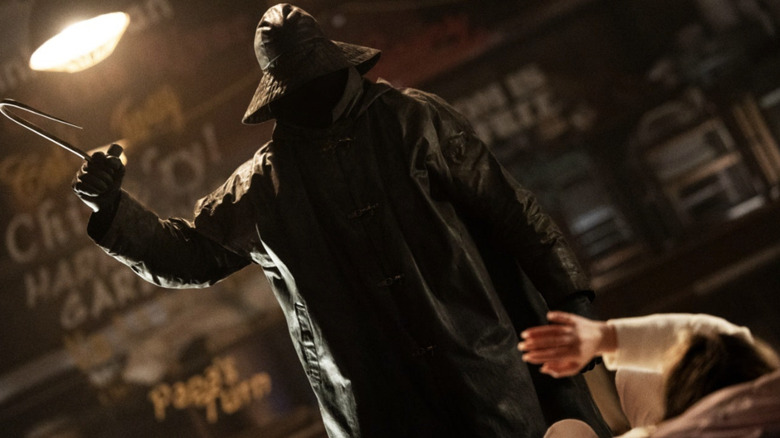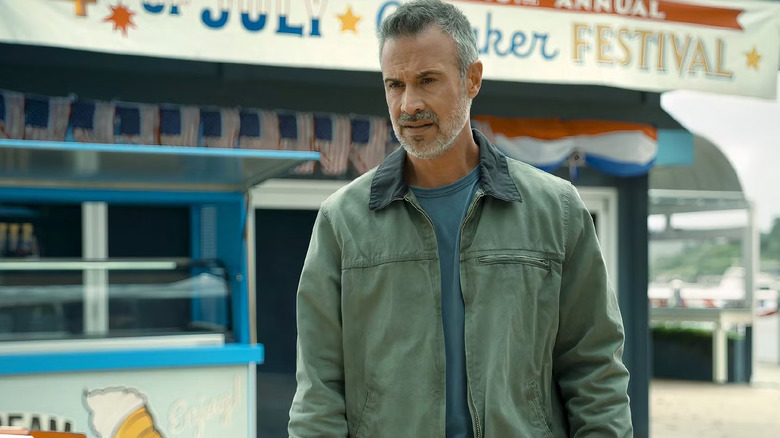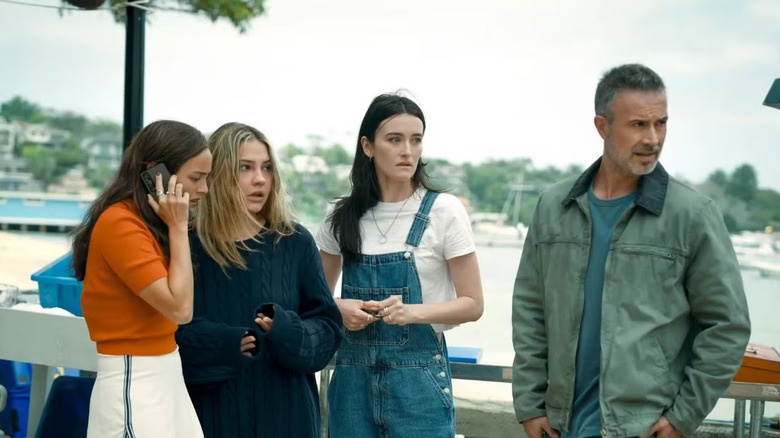
This article contains spoilers for "I Know What You Did Last Summer."
If you're a casual fan of slasher films, you may think an article about who the killer turns out to be in the latest "I Know What You Did Last Summer" movie is fairly standard. Yet the property, despite its resemblance to other slasher franchises, has a few subversive tricks up its sleeve. For one thing, even though it's technically a whodunit film series carrying on the template that began in Lois Duncan's source novel, the reveal
of who the killer or killers are in each film isn't typical. To wit: Ben Willis (Muse Watson) was the killer in both the original 1997 movie and its sequel, 1998's "I Still Know What You Did Last Summer," which added Willis' son Will (Matthew Settle) as his accomplice. In the direct-to-video sequel "I'll Always Know What You Did Last Summer," the Fisherman was revealed to not even be human at all and was instead an undead ghost who took on Willis' Fisherman mantle. When it comes to this franchise, all bets are well and truly off.
Given that director/co-writer Jennifer Kaytin Robinson introduces a whole new pack of characters in her "I Know What You Did Last Summer" legacy sequel, the whodunit game can begin all over again, with new suspects and new red herrings to take the places of the Very, Very Dead Ben and his son. Indeed, one of these new faces turns out to be one of the film's Fisherman killers: Stevie Ward (Sarah Pidgeon), the troubled young woman who had a rocky relationship with the film's other young residents of Southport, North Carolina, which only got worse when she was present during their accidental manslaughter of her born again boyfriend last summer. However, just like "I Still Know," this time there are two Fishermen that Ava (Chase Sui Wonders), Danica (Madelyn Cline), and their friends need to worry about, and the other one is a bit of a doozy.
Yes, the companion killer turns out to be none other than Ray Bronson (Freddie Prinze Jr.), a survivor of the massacre committed by Willis in Southport in 1997 and Willis and his son in the Bahamas in 1998. This revelation is notable for a few reasons: It's one of the rare instances where a legacy hero character is turned into a villain, it acts as a payoff for the property's longstanding red herring involving Ray, and, rather than being a cheap twist, the reveal neatly fits into the franchise's themes of guilt and trauma having the power to ruin the lives of those who let it. It's a smart choice for a film — nay, a brand — that's too often derided for being silly.
Read more: The 15 Best Sequels To Bad Movies
Ray's Reveal Is A Payoff To What, In Retrospect, Is Two Films' Worth Of Setup

In just about any other franchise (slasher or otherwise), the reveal of a hero character as a legacy sequel's villain would be essentially verboten. (For proof, look no further than the childish backlash against making Luke Skywalker a fascinatingly dimensional character in "Star Wars: Episode VIII -- The Last Jedi.") The only film prior to "I Know What You Did Last Summer" (2025) that really dared to try and subvert expectations this way was 2010's "TRON: Legacy," wherein one of Jeff Bridges' characters from the original, the avatar CLU, was brought back as the movie's big bad. But where that film was able to have its cake and eat it too via the fact that Bridges could play both the de-aged villain and the regularly aged human hero Kevin Flynn, "Last Summer" makes the bold choice to fully commit to Ray's heel turn.
Yet, crucially, Ray becoming a killer in "Last Summer" is not a development that comes out of nowhere. In a way, Ray's entire arc in the "Last Summer" movies has led to this, as he was arguably the number one suspect in both "I Know What You Did Last Summer" (1997) and "I Still Know" before the Fishermen reveals were made. This is partially thanks to the biggest twist in Duncan's novel, where the protagonist Julie's boyfriend turns out to be a relative of the boy that she and her friends accidentally killed one fateful summer night -- and is thus the guy who's been threatening them all out of revenge. The first two films making Ray a big suspect not only pays homage to this twist but also the one in the original "Scream," which "Last Summer" '97 writer Kevin Williamson also penned. In that movie, the boyfriend of the protagonist turned out to be one of the killers, so Williamson was riffing on himself as much as he was Duncan's story, and it's an aspect that happened to be carried into the sequel by those who made that film.
Although it certainly wasn't the intention of the filmmakers to play a long game with Ray, the fact that Prinze Jr. had to play the character in the first two movies with the possibility in mind that he may be the killer means that Ray's portrayal fits nicely into the new film's reveal. Ironically, Ray's whole vibe even led to Mike Mendez pitching an entirely separate "Last Summer" sequel idea years ago, in which Ray would have also been revealed as one of the killers (for different reasons than in Robinson's film, of course). Thanks to all this, the Ray reveal hardly feels like some shocking betrayal of the character, allowing it to come across more like the bold and intriguing idea that it is.
Last Summer Uses Its Killers To Underline The Franchise's Themes (And Provide Some Meta Commentary)

One of the most compelling themes of the "Last Summer" films is the concept of trauma and guilt ruining the lives of those who let them. For her movie, Robinson, along with co-writer Sam Lansky, does a neat trick where people and events are disturbingly similar yet eerily different from each other. The main cast of characters resemble the archetypes of the original 1997 group — Danica is also a Croaker Queen, just like Helen Shivers (Sarah Michelle Gellar) was before her — yet this isn't merely history repeating or a meta "recasting," as 2022's "Scream" has it. Instead, the parallels stem from the entire town of Southport's insistence on suppressing and covering up its own collective guilt and trauma, with the town's authorities having literally and figuratively erased its past so as to draw in more tourists.
There are not only echoes of films like "Jaws 2" and "Freddy Vs. Jason" there, but also some meta commentary on the "Last Summer" franchise itself. Stevie's motivation for her murders stem from her trauma surrounding her past and the accidental death of her beau, yet Ray's motivation involves the town that he's lived in all his life trying to sweep his trauma and survivor's guilt under the rug. In essence, the town wishes to deny not only that the Willis killings ever happened but that they could happen again, so Ray seeks to prove them wrong by making them do just that. It's this growing emotional and ethical divide that led to Julie and Ray splitting up between "I Still Know" and this movie. In contrast to Ray descending into murderous rage, Julie, ever the Final Girl, refuses to let her own trauma and guilt consume her.
The biggest example of the divergent responses of each character lies in how they (and, by extension, the film) treat the not so beloved "I Still Know." Ray has a great one-liner where he warns the young cast that fleeing to the Bahamas is a terrible idea, a meta note on how the sequel is generally not well regarded. In Julie's case, however, a mid-credits scene sees her eagerly revisit one of the characters from that sequel, Karla (Brandy Norwood), in order to ask for her help with a new mysterious note she's received. In other words, Ray is indignant that "I Know What You Did Last Summer" may be too overlooked, while Julie is only focused on the strongest elements of the franchise. Given how knowingly fun and clever Robinson makes her sequel, it's safe to say the property is firmly on Julie's side.
"I Know What You Did Last Summer" is now playing in theaters.
If you're looking for the easiest way to keep up with all the major movie and TV news, why not sign up to our free newsletter?
Read the original article on SlashFilm.









